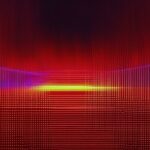Last Updated on 5 months by Francis
Have you ever wondered if infrared can see through clothing? Infrared vision technology has become increasingly popular in recent years, but many people are still unsure about its capabilities. In this article, we will explore the truth about infrared and its potential to see through clothing.
Before we dive into the details, let’s first understand what infrared vision technology is. Infrared is a type of electromagnetic radiation with wavelengths longer than that of visible light. It is commonly used in night vision devices, thermal imaging cameras, and remote temperature sensors.
So, can infrared see through clothing? The answer is not straightforward. While infrared radiation can pass through some types of fabric, it is not capable of penetrating all materials. Additionally, the transparency of clothing depends on the specific wavelength of the infrared radiation being used.
In the following sections, we will explore the capabilities and limitations of infrared in clothing analysis and see-through detection. By the end of this article, you will have a better understanding of what infrared can and cannot do when it comes to seeing through clothing.
Contents
Key Takeaways:
- Infrared vision technology uses electromagnetic radiation with wavelengths longer than visible light.
- Infrared radiation can pass through some types of fabric but not all.
- The transparency of clothing depends on the specific wavelength of infrared radiation being used.
- The following sections will explore the capabilities and limitations of infrared in clothing analysis and see-through detection.
Understanding Infrared Vision Technology

Before diving into the question of whether infrared can see through clothing, it’s essential to understand the basics of infrared vision technology. Infrared technology is based on the detection of thermal radiation, which is a type of electromagnetic radiation emitted by objects due to their temperature.
Infrared cameras are designed to detect this radiation and convert it into an image that displays variations in temperature as different colors. This process, known as thermal imaging, allows us to visualize heat signatures and temperature distributions across an object or a scene.
In terms of clothing transparency, thermal imaging is commonly used to identify areas of heat loss or gain in garments. This information can be used to assess the effectiveness of thermal insulation, identify areas of possible discomfort, and optimize clothing design for different environments and activities.
Thermal imaging for clothing can also be used to detect concealed objects or substances, such as weapons or drugs, by identifying areas with abnormal heat signatures. This application is commonly used in security and law enforcement settings to improve detection and enhance safety.
Infrared Vision Technology: How It Relates to Clothing Transparency
When it comes to the question of whether infrared can see through clothing, the answer is not straightforward. While infrared radiation can penetrate some types of fabric, it doesn’t necessarily mean that it can reveal what’s underneath.
Unlike X-rays or other forms of radiation that can penetrate through solid objects, infrared radiation is easily absorbed and reflected by most materials. This means that the level of penetration and transparency depends on the composition, thickness, and color of the fabric, as well as the intensity and wavelength of the infrared radiation.
Moreover, clothing creates a layer of insulation that can trap and redirect the heat emitted by the body, making it harder to distinguish between the heat signature of the clothing and the heat signature of the body itself.
In conclusion, while infrared vision technology can be used for thermal imaging of clothing and detecting concealed objects, its ability to see through clothing depends on various factors and is not a reliable means of achieving transparency detection. In the following sections, we will explore the topic of infrared penetration through fabric, the impact of infrared radiation on clothing visibility, and the role of infrared technology in see-through clothing detection in more detail.
Exploring Infrared Penetration Through Fabric
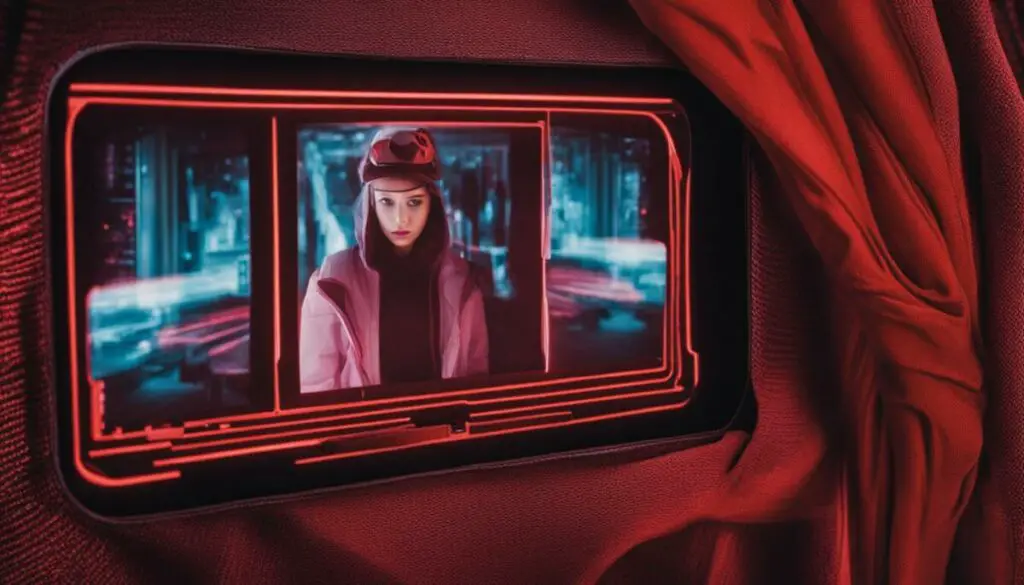
When discussing infrared technology and its potential to see through clothing, it’s essential to understand how infrared waves interact with various types of fabric. Infrared radiation refers to the heat generated by an object in the form of electromagnetic radiation, which is then picked up by infrared cameras.
It’s important to note that not all types of fabric are created equal in terms of their infrared penetration abilities. Some materials, like cotton, are more transparent to infrared radiation, while others, such as silk or polyester, are less transparent. This is due to the composition and density of the fabric.
To illustrate this concept, we can look at a hypothetical scenario where a person hides a metal object under different types of clothing. If they were wearing a cotton shirt, the metal object would be more easily detectable by an infrared camera compared to if they were wearing a silk blouse. This is because cotton allows more infrared radiation to pass through, making the object more visible to the camera.
| Fabric Type | Infrared Penetration |
|---|---|
| Cotton | High |
| Silk | Low |
| Polyester | Medium |
Additionally, infrared cameras can be used to detect hidden objects or substances concealed within clothing. This is due to the fact that different materials will absorb or reflect infrared radiation differently. For example, if a person is attempting to smuggle drugs under their clothing, the drugs may absorb infrared radiation, making them appear as a dark spot on the infrared image.
It’s essential to understand how different types of fabric interact with infrared radiation to accurately assess the potential capabilities of infrared technology in seeing through clothing.
Overall, while infrared technology holds promise in detecting transparency and concealed objects within clothing, it’s important to consider the limitations and potential errors that can occur. A thorough understanding of how infrared radiation interacts with fabric is crucial in utilizing this technology effectively.
The Influence of Infrared Radiation on Clothing Visibility
Infrared radiation has a significant impact on the visibility of clothing, affecting how it may appear under certain lighting conditions or to specific detection technologies. Infrared imaging can be utilized for garment analysis and provide valuable insight into how clothing may interact with different types of radiation.
However, it’s important to note that infrared imaging is not a perfect solution for analyzing clothing. The results may vary depending on the fabric composition, color, and texture, as well as the type and intensity of infrared radiation used.
Infrared Imaging for Garment Analysis
Infrared imaging is a non-destructive testing method that can be used to identify and analyze different materials based on their thermal properties. When it comes to clothing analysis, thermal imaging can provide detailed information on how clothing interacts with infrared radiation.
By detecting the amount of infrared radiation absorbed and emitted by different areas of the garment, thermal imaging can reveal potential weaknesses or inconsistencies in the fabric. For example, areas that absorb or emit more radiation may indicate thermal conductivity issues, while areas with less radiation may suggest insulation problems.
The Effects of Infrared Radiation on Clothing Visibility
In addition to providing insights into fabric properties, infrared radiation can also influence clothing visibility. Certain materials, such as polyester or synthetic blends, may absorb and reflect infrared radiation in different ways than natural materials, such as cotton or wool.
This can result in variations in visible light transmission (VLT), meaning that clothing may appear differently under different lighting and radiation conditions. For example, a black polyester shirt may appear more transparent under infrared light than a white cotton shirt.
Infrared radiation can also affect how clothing appears under different types of detection methods, such as those used in security or surveillance settings. While infrared imaging can be effective for identifying certain types of clothing transparency, it may not detect more subtle variations or differences in fabric composition.
The Role of Infrared Technology in See-Through Clothing Detection
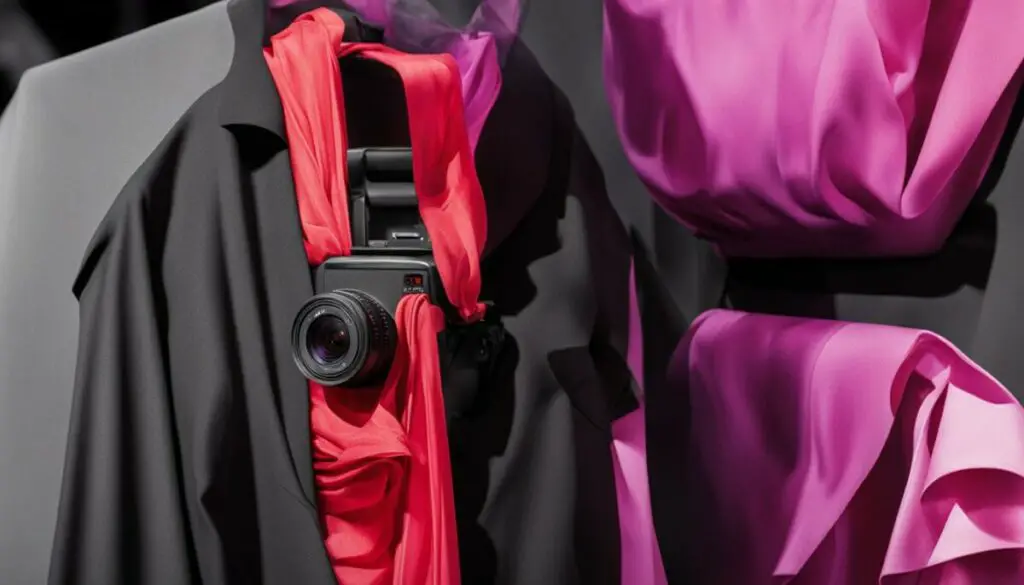
Now that we have a better understanding of infrared technology, let’s explore its application in detecting see-through clothing. Thermal cameras, which use infrared technology to detect heat signatures, can be used to identify transparent or revealing garments.
When a thermal camera is pointed at an individual, it registers the heat signatures emitted from their body. However, when the camera is pointed at clothing, it registers the heat signatures emitted from the fabric. This allows the camera to detect areas where the fabric is thinner or where the body’s heat signature is more pronounced, providing insight into potential areas of transparency or revealing clothing.
Thermal cameras have been used in various industries to assist in detecting clothing transparency, such as in entertainment media to ensure compliance with broadcast standards and in security settings to prevent individuals from concealing weapons or substances within their clothing.
It’s important to note that while thermal cameras can be useful in detecting clothing transparency, they can also produce false positives. For example, areas of clothing that are thinner due to natural wear or tear may register as transparent even though they are not intentionally revealing.
Real-Life Example: Thermal Cameras in the Entertainment Industry
The entertainment industry is one example of an industry that uses thermal cameras to detect clothing transparency. In 2015, the Federal Communications Commission introduced new regulations requiring broadcasters to ensure that their talent’s clothing did not violate decency standards.
Thermal cameras were used to detect potential violations by capturing heat signatures and highlighting areas of clothing that may be too sheer or revealing. This allowed the broadcasters to make necessary adjustments to avoid any potential violations.
The Benefits and Drawbacks of Infrared in Clothing Analysis
The use of infrared technology in detecting clothing transparency has its benefits and drawbacks. On one hand, it can be a useful tool in various industries to ensure compliance with regulations or to enhance security measures. On the other hand, the technology can produce false positives and may not be entirely reliable in detecting intentional clothing transparency.
Overall, the use of infrared technology in clothing analysis should be approached with caution, but it can be a valuable tool when used correctly.
Understanding the Limitations of Infrared in Clothing Analysis
While infrared technology has shown promise in clothing analysis, it still has its limitations. One of the main constraints of using infrared imaging for garment analysis is its ability to penetrate certain materials. Infrared radiation has difficulty penetrating dense materials such as leather and denim, which can limit its use in detecting transparency.
Another limitation is the potential for false positives or negatives. Infrared cameras can sometimes misinterpret or miss certain details, leading to inaccurate results. This can be particularly problematic in settings where transparency detection is essential, such as security screenings or medical examinations.
It’s also important to note that infrared technology is not foolproof when it comes to detecting hidden objects. While it can be effective in identifying certain substances concealed within clothing, it may not pick up others. Additionally, the interpretation of infrared data requires a level of expertise and knowledge that not all personnel may possess.
Despite these limitations, infrared imaging for garment analysis remains a valuable tool in certain contexts. It can provide insights into clothing transparency and be utilized in a variety of industries, including fashion, healthcare, and security. However, it’s essential to understand the boundaries and constraints of this technology to have a realistic perspective on its capabilities.
“Infrared technology is a valuable tool in clothing analysis, particularly in detecting transparency and hidden objects.”
Addressing Common Misconceptions about Infrared and Clothing Transparency
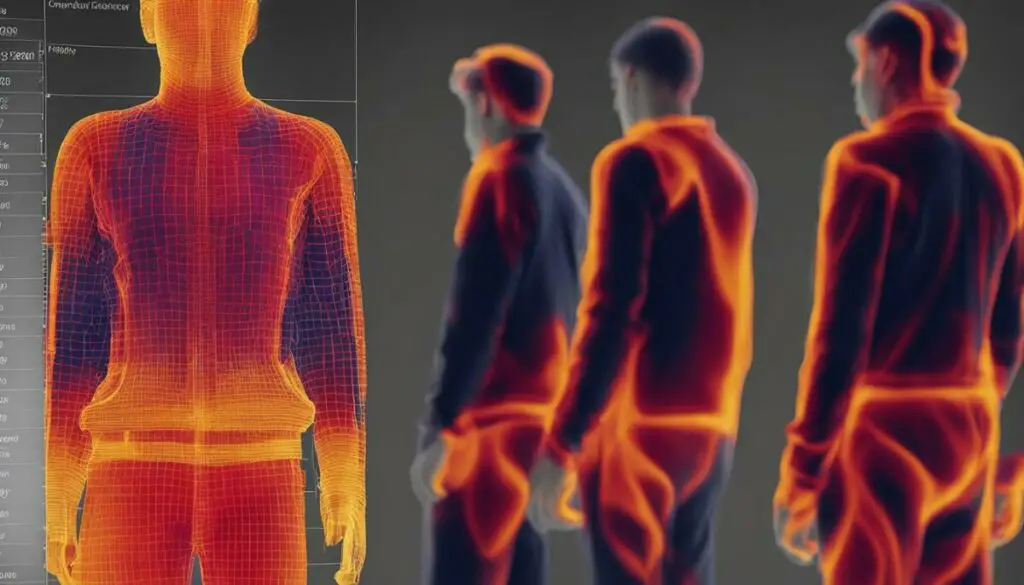
There are numerous misconceptions surrounding the ability of infrared to see through clothing. The use of infrared technology for clothing transparency detection has raised concerns and sparked rumors. Let’s address some common misconceptions:
“Infrared cameras can see through all types of clothing.”
This is not entirely true. While infrared cameras can detect thermal radiation emitted by objects, their ability to see through clothing depends on the type of fabric and its thickness. Some fabrics, such as cotton, absorb infrared radiation and make it difficult for the camera to penetrate. Thicker clothing also makes it harder for infrared to pass through.
“Infrared can see through walls, so it must be able to see through clothing.”
This is a common misconception. While infrared can penetrate some materials, such as certain types of glass, it cannot pass through solid objects like walls. The penetration ability of infrared depends on the type of material and its thickness. Clothing is not a solid object, and therefore, comparing it to walls is not accurate.
“Infrared technology can be used to invade people’s privacy.”
This is a concern that has been raised with the use of infrared for clothing detection. However, it’s important to note that infrared technology is not designed to invade people’s privacy. Its use is intended for security and safety purposes, such as detecting concealed weapons or drugs.
Overall, while infrared technology does have its limitations and potential concerns, it can be a valuable tool in detecting transparency and hidden objects within clothing. By understanding its capabilities and limitations, we can use this technology responsibly and effectively.
The Ethical and Privacy Considerations of Infrared Clothing Detection
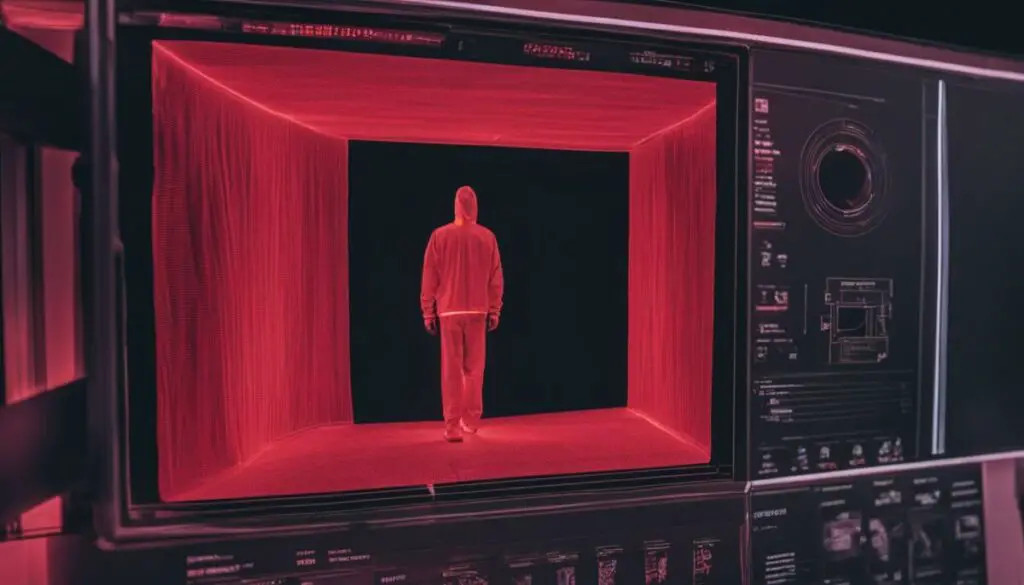
While infrared technology has the potential to revolutionize clothing analysis, it’s crucial to consider the ethical and privacy implications of using it for see-through clothing detection.
One of the primary concerns is the violation of an individual’s privacy rights. The use of infrared cameras to detect clothing transparency raises questions about whether it’s an invasion of privacy to capture images of a person’s body without their consent or knowledge.
Another consideration is the potential for misuse or abuse of this technology. Infrared cameras could potentially be used to invade the privacy of individuals in public spaces or to target vulnerable populations, such as women or children.
Therefore, it’s essential to establish clear guidelines and regulations around the use of infrared technology for clothing analysis. Companies and organizations must ensure that their use of this technology aligns with ethical principles and respects individuals’ privacy rights.
It’s important to balance security measures with privacy rights to ensure that the use of infrared technology for clothing analysis is both effective and ethical.
As infrared technology continues to advance and become more accessible, it’s crucial to address the ethical and privacy considerations associated with its use. This technology has the potential to provide valuable insights and enhance security measures, but it must be implemented responsibly to avoid any negative consequences.
The Future of Infrared in Clothing Analysis
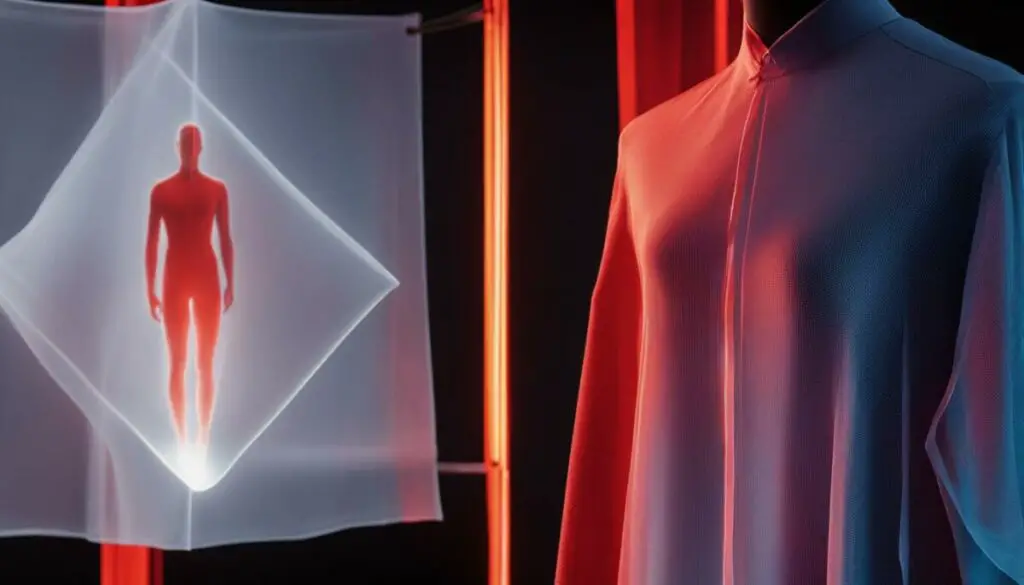
As we’ve explored in previous sections, infrared technology has already shown immense potential in clothing analysis, particularly in the areas of transparency detection and hidden object identification. But what does the future hold for this promising technology? Let’s take a closer look.
Infrared Imaging for Garment Analysis
Infrared imaging has been utilized for garment analysis in industries such as fashion and textiles, providing valuable insights into fabric quality, dye distribution, and even fit testing.
As the technology continues to advance, we can expect more precise and detailed information from infrared imaging, allowing for even more sophisticated garment analysis and design.
Infrared Technology and See-Through Clothing Detection
With the potential for privacy concerns, the application of infrared in see-through clothing detection requires careful consideration.
However, with the development of more advanced and sensitive infrared cameras, we may see improved accuracy and a reduction in false positives. This could lead to more widespread adoption of infrared technology in security and law enforcement settings.
Emerging Trends and Applications
In addition to the areas we’ve already explored, emerging trends in infrared technology may lead to new applications in clothing analysis. One such area is the detection of chemical substances or biological agents hidden within clothing. This could have significant implications for counterterrorism and public safety efforts.
The Potential of Infrared Technology
Overall, the potential of infrared technology in clothing analysis is vast and exciting. While there are limitations to consider and ethical concerns to navigate, the benefits of this technology cannot be ignored.
“Infrared technology has the potential to revolutionize clothing analysis, providing valuable insights into garment quality, transparency, and hidden substances. As the technology continues to advance, we may see more widespread adoption in various industries and settings.”
Exploring Real-Life Applications of Infrared in Clothing Analysis

Now that we understand how infrared vision technology works and its potential limitations, let’s explore some real-life scenarios where it can be applied in clothing analysis.
In the fashion industry, infrared imaging for garment analysis is becoming increasingly popular to assess the quality and durability of fabrics. It allows designers to identify flaws in the fabric’s weave and detect any defects before production. This saves time and money in the long run, preventing the production of garments that do not meet quality standards.
Infrared technology is also utilized in the security industry to detect hidden objects concealed within clothing. It has been proven effective in identifying contraband, such as drugs or weapons, in correctional facilities and airports. By detecting hidden objects with infrared, security personnel can maintain safety and security while minimizing physical searches.
An interesting application of infrared technology is in the medical sector. Infrared imaging can be used to diagnose skin conditions and detect underlying medical issues. It can also be used to monitor the healing process of burn victims by assessing changes in skin temperature.
As shown in the table below, infrared technology can also be applied in various industries, from agriculture to automotive manufacturing, to detect hidden objects and ensure quality control.
| Industry | Application of Infrared Technology |
|---|---|
| Agriculture | Detecting crop health and moisture levels in soil |
| Automotive Manufacturing | Detecting flaws in engine components and identifying hotspots in brake systems |
| Electronics | Detecting hotspots and defects in circuit boards |
In conclusion, infrared technology offers a wide range of practical applications in clothing analysis. From identifying transparency and hidden objects to detecting flaws in fabric and assessing skin conditions, infrared imaging has proven to be a valuable tool in various industries. As advancements continue, we can expect to see further developments and applications of infrared technology in the future.
The Benefits and Drawbacks of Infrared in Clothing Analysis
As we have explored in previous sections, infrared technology can have significant advantages in clothing analysis, particularly in detecting transparency and hidden objects. However, it also has its limitations that must be considered. Below, we will weigh the pros and cons of using infrared in this field.
The Benefits of Infrared in Clothing Analysis
One of the main advantages of infrared technology in clothing analysis is its ability to detect transparency. Thermal imaging for clothing allows us to see through materials and identify any areas that may be revealing. This can be particularly useful in industries such as fashion and entertainment, where clothing transparency can be a significant factor.
Infrared can also be used to detect hidden objects or substances that may be concealed within clothing, such as weapons or drugs. This can be beneficial in security settings where a comprehensive search is essential.
Additionally, infrared imaging for garment analysis can provide valuable insights into the construction and design of clothing. By examining the distribution of heat on a garment, we can identify areas that may need reinforcement or areas where heat may be escaping.
The Drawbacks of Infrared in Clothing Analysis
While infrared technology has its advantages, it also has limitations that must be considered. One significant drawback is its inability to see through all types of fabric. Some fabrics, such as thicker materials, may be challenging for infrared cameras to penetrate, making it difficult to detect transparency or hidden objects concealed within.
Another limitation is the expense of the technology. Infrared cameras and equipment can be costly, making it challenging for some industries and businesses to incorporate into their analysis processes. Additionally, the technology requires skilled professionals who can correctly interpret and analyze the data generated, which can be an added expense.
Conclusion
As we conclude this article, it’s clear that the question of whether infrared can see through clothing is a complex one. Through exploring the world of infrared vision technology, we have gained insight into its potential for clothing transparency detection and hidden object identification.
While it’s important to understand the limitations of infrared technology in clothing analysis, there are several real-life applications where it’s currently being used. From garment analysis to security measures, infrared has proven to be a valuable tool in various industries.
The Future of Infrared in Clothing Analysis
Looking towards the future, we can expect to see continued advancements in infrared technology for clothing analysis. Emerging trends show potential for its application in novel ways, such as in healthcare and environmental monitoring.
The Benefits and Drawbacks of Infrared in Clothing Analysis
It’s important to weigh the benefits and drawbacks of using infrared technology in clothing analysis. While infrared cameras can detect transparency and hidden objects, their accuracy and reliability can be affected by various factors, such as the type of fabric and temperature changes.
In Conclusion
Overall, infrared technology is a valuable tool in clothing analysis, but it’s important to be mindful of its limitations and potential privacy concerns. As advancements continue, we can expect further developments and applications in this field.
FAQ
Can infrared see through clothing?
Infrared technology cannot see through clothing. It can detect the heat emitted by objects, including the human body, but it cannot penetrate clothing materials to see what is underneath.
How does infrared vision technology work?
Infrared vision technology works by detecting the heat signatures emitted by objects. Infrared cameras capture the infrared radiation and convert it into a visible image based on the variation in temperature.
Yes, infrared technology can be used to detect hidden objects or substances concealed within clothing. By analyzing the variations in heat patterns, it is possible to identify anomalies that may indicate the presence of hidden objects.
Does infrared radiation affect the visibility of clothing?
Infrared radiation does not significantly impact the visibility of clothing. However, infrared imaging can be used for garment analysis to assess factors such as insulation, fabric quality, and heat distribution.
How is infrared technology used in see-through clothing detection?
Infrared technology, specifically thermal cameras, can assist in identifying transparent or revealing garments. By detecting temperature differences and variations, thermal cameras can highlight areas of the body or clothing that may be more transparent.
What are the limitations of using infrared for clothing analysis?
The limitations of using infrared for clothing analysis include the inability to see through clothing, the reliance on temperature differences rather than visual clarity, and the potential interference from external factors such as environmental conditions and clothing layers.
What are common misconceptions about infrared and clothing transparency?
Common misconceptions include the belief that infrared can see through clothing, that it provides a clear visual representation of hidden objects, and that it is a foolproof method for detecting transparency. In reality, infrared technology has its limitations and should be used in conjunction with other methods.
What ethical and privacy considerations are associated with infrared clothing detection?
The use of infrared technology for clothing detection raises concerns about privacy rights and the potential invasion of personal space. Balancing security measures with individual privacy is crucial in implementing and using this technology responsibly.
What is the future of infrared in clothing analysis?
The future of infrared in clothing analysis holds potential for advancements in accuracy, sensitivity, and efficiency. As research and development continue, we can expect to see improved capabilities and expanded applications of infrared technology in this field.
What are some real-life applications of infrared in clothing analysis?
Real-life applications of infrared technology in clothing analysis include detecting hidden objects in security screenings, assessing garment insulation in outdoor apparel manufacturing, and identifying abnormalities in medical thermography for diagnostic purposes.
What are the benefits and drawbacks of using infrared in clothing analysis?
The benefits of using infrared technology in clothing analysis include transparency detection, hidden object identification, and non-invasive evaluation of fabric properties. However, drawbacks include limitations in visual clarity and the need for expertise in interpreting thermal images.





